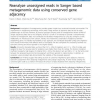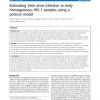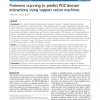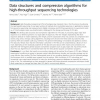BMCBI
2010
13 years 11 months ago
2010
Background: Investigation of metagenomes provides greater insight into uncultured microbial communities. The improvement in sequencing technology, which yields a large amount of s...
BMCBI
2010
13 years 11 months ago
2010
Background: Genome sequencing projects have expanded the gap between the amount of known protein sequences and structures. The limitations of current high resolution structure det...
BMCBI
2010
13 years 11 months ago
2010
Background: The occurrence of a genetic bottleneck in HIV sexual or mother-to-infant transmission has been well documented. This results in a majority of new infections being homo...
BMCBI
2010
13 years 11 months ago
2010
Background: The rapid development of structural genomics has resulted in many "unknown function" proteins being deposited in Protein Data Bank (PDB), thus, the functiona...
BMCBI
2010
13 years 11 months ago
2010
Background: PDZ domains mediate protein-protein interactions involved in important biological processes through the recognition of short linear motifs in their target proteins. Tw...
BMCBI
2010
13 years 11 months ago
2010
Background: High-throughput sequencing (HTS) technologies play important roles in the life sciences by allowing the rapid parallel sequencing of very large numbers of relatively s...
BMCBI
2010
13 years 11 months ago
2010
Background: Drugs can influence the whole metabolic system by targeting enzymes which catalyze metabolic reactions. The existence of interactions between drugs and metabolic react...
BMCBI
2010
13 years 11 months ago
2010
Background: Primer and probe sequences are the main components of nucleic acid-based detection systems. Biologists use primers and probes for different tasks, some related to the ...
BMCBI
2010
13 years 11 months ago
2010
Background: While occurring enzymatically in biological systems, O-linked glycosylation affects protein folding, localization and trafficking, protein solubility, antigenicity, bi...
BMCBI
2010
13 years 11 months ago
2010
Background: Much of the public access cancer microarray data is asymmetric, belonging to datasets containing no samples from normal tissue. Asymmetric data cannot be used in stand...





